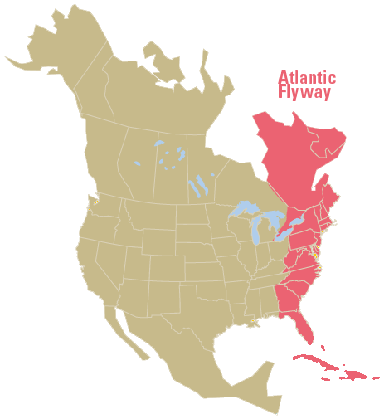Wicomico River's Common Visitors
These birds below are the more common waterfowl species seen on the Wicomico River as they are visiting and/or living in the area. The only species I would recommend eating that are of good tasting quality would be Canadian Geese and Puddle/Dabbling Ducks. At times other waterfowl visitors going through the Atlantic Flyway may stop by the river and can be identified on the Ducks Unlimited Website or by downloading any of the Ducks Unlimited Apps. More information on birds in the area can be found in the Nature section.
Puddle Ducks
Puddle ducks (also known as dabbling ducks) are typically birds of fresh, shallow marshes and rivers rather than of large lakes and bays. They are good divers, but usually feed by dabbling or tipping rather than submerging
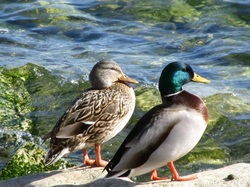 Photo by: Jo Smith
Photo by: Jo Smith
Mallard (Males AKA: Green Heads)
Habitat
Lakes, ponds, rivers, potholes, woodland pools and surrounding uplands
Range
The mallard is the most common duck in the United States, with the greatest abundance between the Appalachian and Rocky mountains
Diet
Wetland vegetation, seeds, mollusks, crustaceans, insects and larvae
Males
White neck-ring separates the green head from the chestnut-brown chest, contrasts with the gray sides, brownish back, black rump and black upper- and under-tail coverts. The speculum is violet-blue bordered by black and white, and the outer tail feathers are white. The bill is yellow to yellowish-green and the legs and feet are coral-red
Females
A mottled brownish color and has a violet speculum bordered by black and white. The crown of the head is dark brown with a dark brown stripe running through the eye. The remainder of the head is lighter brown than the upper body. The bill is orange splotched with brown, and the legs and feet are orange. Female is especially vocal with the characteristic series of quacks
Habitat
Lakes, ponds, rivers, potholes, woodland pools and surrounding uplands
Range
The mallard is the most common duck in the United States, with the greatest abundance between the Appalachian and Rocky mountains
Diet
Wetland vegetation, seeds, mollusks, crustaceans, insects and larvae
Males
White neck-ring separates the green head from the chestnut-brown chest, contrasts with the gray sides, brownish back, black rump and black upper- and under-tail coverts. The speculum is violet-blue bordered by black and white, and the outer tail feathers are white. The bill is yellow to yellowish-green and the legs and feet are coral-red
Females
A mottled brownish color and has a violet speculum bordered by black and white. The crown of the head is dark brown with a dark brown stripe running through the eye. The remainder of the head is lighter brown than the upper body. The bill is orange splotched with brown, and the legs and feet are orange. Female is especially vocal with the characteristic series of quacks
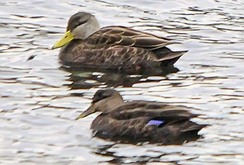 Photo by: Hilke Breder
Photo by: Hilke Breder
American Black Duck
Habitat
Shallow lakes, ponds, streams, bays, coves, mudflats, wetlands, woodland ponds and surrounding uplands
Range
The black duck is found throughout eastern parts of Canada and the United States. They breed in the northeastern U.S. and eastern Canada. The species winters in eastern coastal areas of the U.S., and in open water along the Great Lakes
Diet
Young depend on tree-lined brooks and ponds for larvae from mosquitos and other insects during their first two weeks of life. Mature birds rely on plants
Males and Females
The drake and hen are similar in appearance and are easily distinguished only by the colour of their bill, which is greenish yellow on the drake and dull olive green to black on the hen. Both the male and female black duck resemble a mallard hen, but have a noticeably darker black-brown body that contrasts with their light brown head. Black ducks are similar to mallards in size, and resemble the female mallard in coloration, though the black duck's plumage is darker
Habitat
Shallow lakes, ponds, streams, bays, coves, mudflats, wetlands, woodland ponds and surrounding uplands
Range
The black duck is found throughout eastern parts of Canada and the United States. They breed in the northeastern U.S. and eastern Canada. The species winters in eastern coastal areas of the U.S., and in open water along the Great Lakes
Diet
Young depend on tree-lined brooks and ponds for larvae from mosquitos and other insects during their first two weeks of life. Mature birds rely on plants
Males and Females
The drake and hen are similar in appearance and are easily distinguished only by the colour of their bill, which is greenish yellow on the drake and dull olive green to black on the hen. Both the male and female black duck resemble a mallard hen, but have a noticeably darker black-brown body that contrasts with their light brown head. Black ducks are similar to mallards in size, and resemble the female mallard in coloration, though the black duck's plumage is darker
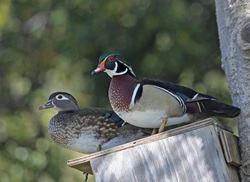 Photo by: Nancy Johnston
Photo by: Nancy Johnston
Wood Duck (AKA: Woodies/Woody)
Habitat
Wooded wetlands, rivers, streams, lake and river edges
Range
Breeds in much of southern Canada and the eastern U.S. but is largely absent from U.S. Prairies, Great Plains and southwest. Winter range includes extreme southern Ontario, the southern U.S. and Mexico (in smaller numbers). In the eastern and western United States, 30-75 percent of wood ducks are permanent residents
Diet
Varied diet includes seeds, fruits, aquatic plants, insects and acorns
Males
Male wood ducks have a crested head that is iridescent green and purple with a white stripe leading from the eye to the end of the crest, and another narrower white stripe from the base of the bill to the tip of the crest. The throat is white and the chest is burgundy with white flecks, gradually grading into a white belly. The bill is brightly patterned black, white and red. The legs and feet are a dull straw yellow and the iris is red
Females
Female wood ducks have a gray-brown head and neck with a brownish, green, glossed crest. A white teardrop shaped patch surrounds the brownish-black eye. The throat is white and the breast is gray-brown stippled with white, fading into the white belly. The back is olive brown with a shimmer of iridescent green. The bill is blue-gray and the legs and feet are dull grayish-yellow. Nesting is typically in tree cavities or nest boxes and they lay an average of 12 bone-white eggs
Habitat
Wooded wetlands, rivers, streams, lake and river edges
Range
Breeds in much of southern Canada and the eastern U.S. but is largely absent from U.S. Prairies, Great Plains and southwest. Winter range includes extreme southern Ontario, the southern U.S. and Mexico (in smaller numbers). In the eastern and western United States, 30-75 percent of wood ducks are permanent residents
Diet
Varied diet includes seeds, fruits, aquatic plants, insects and acorns
Males
Male wood ducks have a crested head that is iridescent green and purple with a white stripe leading from the eye to the end of the crest, and another narrower white stripe from the base of the bill to the tip of the crest. The throat is white and the chest is burgundy with white flecks, gradually grading into a white belly. The bill is brightly patterned black, white and red. The legs and feet are a dull straw yellow and the iris is red
Females
Female wood ducks have a gray-brown head and neck with a brownish, green, glossed crest. A white teardrop shaped patch surrounds the brownish-black eye. The throat is white and the breast is gray-brown stippled with white, fading into the white belly. The back is olive brown with a shimmer of iridescent green. The bill is blue-gray and the legs and feet are dull grayish-yellow. Nesting is typically in tree cavities or nest boxes and they lay an average of 12 bone-white eggs
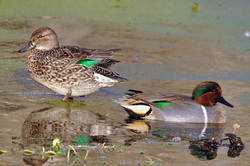 Photo by: Ed Konrad
Photo by: Ed Konrad
Green Winged Teal
Habitat
Prefers shallow ponds with lots of emergent vegetation. Along the coast, it prefers tidal creeks, mudflats, and marshes to more open water.
Range
Breeds throughout Canada, Alaska, northern U.S., Great Plains and the Great Lakes Area. Winters along Pacific coast from Alaska south, in most of U.S., Mexico and Caribbean
Diet
Varied diet including insects and aquatic vegetation that changes with availability of food
Males
Male green-winged teal have a chestnut head with an iridescent green to purple patch extending from the eyes to the nape of the neck. The chest is pinkish-brown with black speckles, and the back, sides and flanks are gray, separated from the chest by a white bar. The wing coverts are brownish-gray with a green speculum. The bill is dark slate and the legs and feet are dark gray. Males have a distinctive high-pitched sound
Females
Female green-winged teal are mottled brown with a dark brown line that extends from the bill through the eye. The bill is dark gray and the legs and feet are olive-gray to brownish-gray. Relatively silent but has a sharp, high "quack"
Habitat
Prefers shallow ponds with lots of emergent vegetation. Along the coast, it prefers tidal creeks, mudflats, and marshes to more open water.
Range
Breeds throughout Canada, Alaska, northern U.S., Great Plains and the Great Lakes Area. Winters along Pacific coast from Alaska south, in most of U.S., Mexico and Caribbean
Diet
Varied diet including insects and aquatic vegetation that changes with availability of food
Males
Male green-winged teal have a chestnut head with an iridescent green to purple patch extending from the eyes to the nape of the neck. The chest is pinkish-brown with black speckles, and the back, sides and flanks are gray, separated from the chest by a white bar. The wing coverts are brownish-gray with a green speculum. The bill is dark slate and the legs and feet are dark gray. Males have a distinctive high-pitched sound
Females
Female green-winged teal are mottled brown with a dark brown line that extends from the bill through the eye. The bill is dark gray and the legs and feet are olive-gray to brownish-gray. Relatively silent but has a sharp, high "quack"
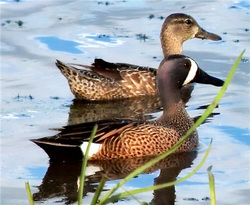 Photo by: Don Keith
Photo by: Don Keith
Blue Winged Teal
Habitat
Grasslands bordering small potholes and other freshwater wetlands.
Range
Breeds throughout much of Canada, Alaska, and northern United States south through Great Plains to gulf coast of Texas and Louisiana. Winters in extreme southern U.S., Mexico, central America, Caribbean and the majority winter in northern parts of South America.
Diet
Diet varies with location and season. Feeds on aquatic invertebrates, seeds, aquatic vegetation and occasionally agricultural grains. Egg-laying females feeds heavily on animal matter
Males
Male blue-winged teal have a slate gray head and neck, a black-edged white crescent in front of the eyes and a blackish crown. The breast and sides are tan with dark brown speckles and there is a white spot on the side of the rump. Most of the upper wing coverts are blue-gray, the secondaries form an iridescent green speculum and the underwing is whitish. The bill is black and the legs and feet are yellowish to orange. The male has a thin whistled sound uttered both in flight and when on water.
Females
Female blue-winged teal have a brownish-gray head with a darker crown and eye stripe. The breast and sides are brown, the upper parts are olive brown, and the upper wing coverts are bluish, but less vibrant than the drake. The bill is gray-black and the legs and feet are dull yellow-brown. The female has a high-pitched squeak.
Habitat
Grasslands bordering small potholes and other freshwater wetlands.
Range
Breeds throughout much of Canada, Alaska, and northern United States south through Great Plains to gulf coast of Texas and Louisiana. Winters in extreme southern U.S., Mexico, central America, Caribbean and the majority winter in northern parts of South America.
Diet
Diet varies with location and season. Feeds on aquatic invertebrates, seeds, aquatic vegetation and occasionally agricultural grains. Egg-laying females feeds heavily on animal matter
Males
Male blue-winged teal have a slate gray head and neck, a black-edged white crescent in front of the eyes and a blackish crown. The breast and sides are tan with dark brown speckles and there is a white spot on the side of the rump. Most of the upper wing coverts are blue-gray, the secondaries form an iridescent green speculum and the underwing is whitish. The bill is black and the legs and feet are yellowish to orange. The male has a thin whistled sound uttered both in flight and when on water.
Females
Female blue-winged teal have a brownish-gray head with a darker crown and eye stripe. The breast and sides are brown, the upper parts are olive brown, and the upper wing coverts are bluish, but less vibrant than the drake. The bill is gray-black and the legs and feet are dull yellow-brown. The female has a high-pitched squeak.
Diving Ducks
Diving ducks (divers) frequent the larger, deeper lakes and rivers, and coastal bays and inlets. They feed by diving, often to considerable depths. To escape danger, they can travel great distances underwater, emerging only enough to show their head before submerging again
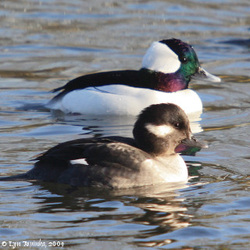 Photo by: Lyn Topinka
Photo by: Lyn Topinka
Bufflehead
Habitat
Large lakes, rivers, and bays
Range
Buffleheads are believed to congregate on large lakes or in major river systems until freeze-up in the fall, or immediately after thaw in the spring. Buffleheads from eastern Alberta migrate to the eastern United States along the Atlantic flyway and the Gulf Coast of Mexico, and birds from western Canada migrate south along the Pacific Flyway. They concentrate along the coasts during the winter, with no particular area wintering the majority of the population
Diet
Insects, small aquatic organisms, aquatic plants
Males
Male Buffleheads have a large white patch across the back of the head that extends from cheek to cheek, forming a bushy crest. The remainder of the head is blackish with an iridescent green and purple sheen. The neck, scapulars, breast, belly and sides are white, and the back and rump are black. The upper wing surface is blackish except for the white speculum extending from the inner and middle secondaries across to the outer lesser and marginal coverts. The bill is light blue-gray and the legs and feet are fleshy pink
Females
Female Buffleheads have a brownish head and neck, except for an oval white patch that extends from below the eye back towards the nape of the neck. The breast, sides and flanks are dark gray, the back is blackish, the belly is whitish and the tail is grayish-brown. The upper wing surface is blackish-brown, except for the inner and middle secondaries and inner greater coverts, which are white, tipped with black. The bill is dark gray and the legs and feet are grayish
Habitat
Large lakes, rivers, and bays
Range
Buffleheads are believed to congregate on large lakes or in major river systems until freeze-up in the fall, or immediately after thaw in the spring. Buffleheads from eastern Alberta migrate to the eastern United States along the Atlantic flyway and the Gulf Coast of Mexico, and birds from western Canada migrate south along the Pacific Flyway. They concentrate along the coasts during the winter, with no particular area wintering the majority of the population
Diet
Insects, small aquatic organisms, aquatic plants
Males
Male Buffleheads have a large white patch across the back of the head that extends from cheek to cheek, forming a bushy crest. The remainder of the head is blackish with an iridescent green and purple sheen. The neck, scapulars, breast, belly and sides are white, and the back and rump are black. The upper wing surface is blackish except for the white speculum extending from the inner and middle secondaries across to the outer lesser and marginal coverts. The bill is light blue-gray and the legs and feet are fleshy pink
Females
Female Buffleheads have a brownish head and neck, except for an oval white patch that extends from below the eye back towards the nape of the neck. The breast, sides and flanks are dark gray, the back is blackish, the belly is whitish and the tail is grayish-brown. The upper wing surface is blackish-brown, except for the inner and middle secondaries and inner greater coverts, which are white, tipped with black. The bill is dark gray and the legs and feet are grayish
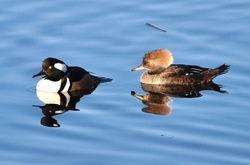 Photo by: Hal Kennedy
Photo by: Hal Kennedy
Hooded Merganser
Habitat
Hooded mergansers are found in densely wooded streams or small wetlands where there is little human disturbance or activity. Older forests are preferred. Winters on shallow freshwater and brackish bays, estuaries, tidal creeks and ponds as well as emergent marshes, wetlands and creeks
Range
Of the three species of mergansers occurring in North America, the hooded merganser is the only one restricted to the continent. Forested wetlands, brackish estuaries and tidal creeks are preferred wintering habitats. Hooded mergansers winter along the Pacific, Atlantic, and Gulf coasts, mainly from southeastern Alaska to northern Baja California, and New England to Florida and west to northern Mexico. The majority of wintering hooded mergansers occur in the Mississippi Flyway
Diet
Consists of mainly small fishes, crustaceans, aquatic insects and amphibians
Males
Male hooded mergansers have a large white crest surrounded by black. The top of the head, neck and back are all black, and the chest, breast and belly are white. Wavy black lines can be seen on the tawny sides and flanks. The hindback, rump and tail are dark brown. The long, narrow, serrated bill is black. The iris is bright yellow and the legs and feet are dull yellow
Females
Female hooded mergansers have a gray-brown head and neck with a reddish-brown crest. Gray pervades their neck, chest, sides and flanks, and brownish-black dominates their back, rump and tail. The upper bill is black-edged with orange and the lower bill is yellow. The legs and feet are greenish in color and the iris is brown
Habitat
Hooded mergansers are found in densely wooded streams or small wetlands where there is little human disturbance or activity. Older forests are preferred. Winters on shallow freshwater and brackish bays, estuaries, tidal creeks and ponds as well as emergent marshes, wetlands and creeks
Range
Of the three species of mergansers occurring in North America, the hooded merganser is the only one restricted to the continent. Forested wetlands, brackish estuaries and tidal creeks are preferred wintering habitats. Hooded mergansers winter along the Pacific, Atlantic, and Gulf coasts, mainly from southeastern Alaska to northern Baja California, and New England to Florida and west to northern Mexico. The majority of wintering hooded mergansers occur in the Mississippi Flyway
Diet
Consists of mainly small fishes, crustaceans, aquatic insects and amphibians
Males
Male hooded mergansers have a large white crest surrounded by black. The top of the head, neck and back are all black, and the chest, breast and belly are white. Wavy black lines can be seen on the tawny sides and flanks. The hindback, rump and tail are dark brown. The long, narrow, serrated bill is black. The iris is bright yellow and the legs and feet are dull yellow
Females
Female hooded mergansers have a gray-brown head and neck with a reddish-brown crest. Gray pervades their neck, chest, sides and flanks, and brownish-black dominates their back, rump and tail. The upper bill is black-edged with orange and the lower bill is yellow. The legs and feet are greenish in color and the iris is brown
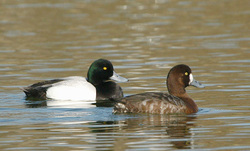 Photo by: Albert Steen-Hansen
Photo by: Albert Steen-Hansen
Lesser Scaup (AKA "Blue Bill")
Habitat
Wetlands with large quantities of submergent and emergent vegetation, which are important for feeding, nesting and cover
Range
Lesser scaup start moving north from their wintering grounds in the southern U.S. in February. They arrive on their breeding grounds from Alaska, B.C., across the Canadian prairies and into the northern Great Plains of the U.S. from late March to early June. In the fall, they are some of the last ducks to venture south. Greater Scaups are typically counted in population with lesser scaups as they share a lot of the same characteristics
Diet
They make short dives for food. Food is either taken from the water column or by shovelling through soft bottom substrates. They feed on aquatic invertebrates like amphipods, midges, clams, snails and zebra mussels in the early breeding season and seeds from aquatic plants in the late summer
Males
Male lesser scaup have a glossy black head with a purple cast. The neck, breast and upper mantle are glossy black. Vermiculations on the sides and flanks are olive brown and contrast with the white chest and belly. The back is light gray with broad heavy vermiculations of sooty black. The tail, upper and under-tail coverts are black. The wing has a white speculum and the inner primaries are light brown, becoming darker towards the tips and outer primaries. The bill is a light blue-gray with a black nail, the legs and feet are gray and the iris is yellow. The male utters weak whistling notes
Females
Female lesser scaup have a brownish head, neck and chest, and white oval patches around their bills. The back, rump and scapulars are dark brown and the speculum is white. The bill is similar to that of the male but slightly duller, the legs and feet are gray and the iris is yellow
Habitat
Wetlands with large quantities of submergent and emergent vegetation, which are important for feeding, nesting and cover
Range
Lesser scaup start moving north from their wintering grounds in the southern U.S. in February. They arrive on their breeding grounds from Alaska, B.C., across the Canadian prairies and into the northern Great Plains of the U.S. from late March to early June. In the fall, they are some of the last ducks to venture south. Greater Scaups are typically counted in population with lesser scaups as they share a lot of the same characteristics
Diet
They make short dives for food. Food is either taken from the water column or by shovelling through soft bottom substrates. They feed on aquatic invertebrates like amphipods, midges, clams, snails and zebra mussels in the early breeding season and seeds from aquatic plants in the late summer
Males
Male lesser scaup have a glossy black head with a purple cast. The neck, breast and upper mantle are glossy black. Vermiculations on the sides and flanks are olive brown and contrast with the white chest and belly. The back is light gray with broad heavy vermiculations of sooty black. The tail, upper and under-tail coverts are black. The wing has a white speculum and the inner primaries are light brown, becoming darker towards the tips and outer primaries. The bill is a light blue-gray with a black nail, the legs and feet are gray and the iris is yellow. The male utters weak whistling notes
Females
Female lesser scaup have a brownish head, neck and chest, and white oval patches around their bills. The back, rump and scapulars are dark brown and the speculum is white. The bill is similar to that of the male but slightly duller, the legs and feet are gray and the iris is yellow
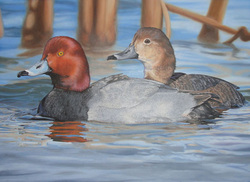 Photo by: Timothy Taylor
Photo by: Timothy Taylor
Redhead
Habitat
Seasonal and semi-permanent wetlands, natural lakes and reservoirs. Prefers deep water wetlands for breeding and brood rearing. Winters in shallow coastal waters with abundant sea grasses
Range
Redheads arrive on the breeding grounds of western and central Canada and the U.S. as soon as the ice breaks in the spring. They are only found in North America and do not exist anywhere else on Earth
Diet
They feed by diving, gleaning from the surface, or dabbling just below the surface. They eat seeds, buds and tubers of submergent aquatic plants, as well as larvae, eggs, snails and other aquatic invertebrates
Males
Male redheads have a reddish head and upper neck with a black lower neck, foreback and breast. The remaining back is a dark grayish color. The hind back and tail are brownish-black. A broad band of light gray extends across the dusky gray wing and out onto the primaries, which helps distinguish it from scaup. The legs and feet are gray, and the bill is light blue-gray with a whitish band behind a relatively wide black tip
Females
Female redheads have a reddish-brown head, neck and breast, with a buff white chin and throat and an indistinct eye ring and stripe behind the eye. The flanks are warm brown, contrasting little with the breast, but with buffer fringes. The upper parts are darker and duller brown, with the upper-wing-coverts browner than on the male; otherwise the wing is similar to that of the male. The bill is duller than the male's, but similar in pattern
Habitat
Seasonal and semi-permanent wetlands, natural lakes and reservoirs. Prefers deep water wetlands for breeding and brood rearing. Winters in shallow coastal waters with abundant sea grasses
Range
Redheads arrive on the breeding grounds of western and central Canada and the U.S. as soon as the ice breaks in the spring. They are only found in North America and do not exist anywhere else on Earth
Diet
They feed by diving, gleaning from the surface, or dabbling just below the surface. They eat seeds, buds and tubers of submergent aquatic plants, as well as larvae, eggs, snails and other aquatic invertebrates
Males
Male redheads have a reddish head and upper neck with a black lower neck, foreback and breast. The remaining back is a dark grayish color. The hind back and tail are brownish-black. A broad band of light gray extends across the dusky gray wing and out onto the primaries, which helps distinguish it from scaup. The legs and feet are gray, and the bill is light blue-gray with a whitish band behind a relatively wide black tip
Females
Female redheads have a reddish-brown head, neck and breast, with a buff white chin and throat and an indistinct eye ring and stripe behind the eye. The flanks are warm brown, contrasting little with the breast, but with buffer fringes. The upper parts are darker and duller brown, with the upper-wing-coverts browner than on the male; otherwise the wing is similar to that of the male. The bill is duller than the male's, but similar in pattern
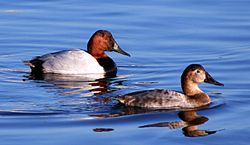 Photo by: Nicholas Del Grosso
Photo by: Nicholas Del Grosso
Canvasback
Habitat
Lakes, ponds, rivers, potholes, woodland pools and surrounding uplands
Range
Breed from Alaska through the Yukon and western edge of the Northwest Territories to the parklands and mixed prairie of central North America.Winters along 3 coasts, principally from San Pablo Bay along the Pacific, to coastal Louisiana, to the Chesapeake Bay on the Atlantic.
Diet
Canvasbacks are physically specialized to consume subterranean plant parts and benthic invertebrates, and procure a great deal of their food by rooting through wetland bottoms with their bills
Males
Male canvasbacks have a chestnut-red head and neck, a black breast, grayish back, black rump and blackish-brown tail. The sides, flank and belly are white, while the wing coverts are grayish and vermiculated with black. The bill is blackish and the legs and feet are bluish-gray. The iris is bright red in the spring, but duller in the winter
Females
Female canvasbacks have a light brown head and neck, grading into a darker brown chest and foreback. The sides, flanks and back are grayish-brown. The bill is blackish and the legs and feet are bluish-gray
Habitat
Lakes, ponds, rivers, potholes, woodland pools and surrounding uplands
Range
Breed from Alaska through the Yukon and western edge of the Northwest Territories to the parklands and mixed prairie of central North America.Winters along 3 coasts, principally from San Pablo Bay along the Pacific, to coastal Louisiana, to the Chesapeake Bay on the Atlantic.
Diet
Canvasbacks are physically specialized to consume subterranean plant parts and benthic invertebrates, and procure a great deal of their food by rooting through wetland bottoms with their bills
Males
Male canvasbacks have a chestnut-red head and neck, a black breast, grayish back, black rump and blackish-brown tail. The sides, flank and belly are white, while the wing coverts are grayish and vermiculated with black. The bill is blackish and the legs and feet are bluish-gray. The iris is bright red in the spring, but duller in the winter
Females
Female canvasbacks have a light brown head and neck, grading into a darker brown chest and foreback. The sides, flanks and back are grayish-brown. The bill is blackish and the legs and feet are bluish-gray
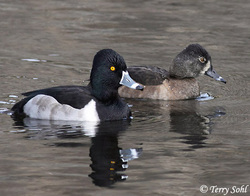 Photo by: Terry Sohl
Photo by: Terry Sohl
Ring-necked Duck
Habitat
Prefer shallow wetlands fringed with emergent, submergent or floating vegetation like bulrush, pondweed and pond lily. Wintering ring-necks can be found on wild rice lakes
Range
Core breeding area is the boreal forest of the Canadian prairies and parts of the Northwest Territories. Ring-necks winter across most of the southern and coastal U.S. as well as Mexico and the Caribbean
Diet
Feed by shallow dives. Eat mostly plant matter like seeds and tubers of submergent vegetation, but also feeds on snails, insects, leeches and other aquatic invertebrates
Males
The "ringneck" name is derived from a faint brownish ring around the base of the neck, which is visible only upon close inspection. The legs and feet are gray-blue and the iris is yellow. Ring-necked ducks are silent except in display, when a low whistling note is uttered. Male ring-necked ducks have an iridescent black head, neck, breast and upperparts. The belly and flanks are whitish to grayish, with a distinctive triangular white wedge extending upward in the area in front of the folded wing. The bill is slate with a white border around the base and nares, and a pale white band behind the black tip
Females
Female ring-necked ducks have a brown head with a black crown, light brown cheeks and chin and a white eye ring. A narrow white line extends from the eye to the back of the head. The bill is slate with a faint white band near the tip. The neck, back, sides and flanks are brown and the belly is white. The legs and feet are gray-blue and the iris is brown
Habitat
Prefer shallow wetlands fringed with emergent, submergent or floating vegetation like bulrush, pondweed and pond lily. Wintering ring-necks can be found on wild rice lakes
Range
Core breeding area is the boreal forest of the Canadian prairies and parts of the Northwest Territories. Ring-necks winter across most of the southern and coastal U.S. as well as Mexico and the Caribbean
Diet
Feed by shallow dives. Eat mostly plant matter like seeds and tubers of submergent vegetation, but also feeds on snails, insects, leeches and other aquatic invertebrates
Males
The "ringneck" name is derived from a faint brownish ring around the base of the neck, which is visible only upon close inspection. The legs and feet are gray-blue and the iris is yellow. Ring-necked ducks are silent except in display, when a low whistling note is uttered. Male ring-necked ducks have an iridescent black head, neck, breast and upperparts. The belly and flanks are whitish to grayish, with a distinctive triangular white wedge extending upward in the area in front of the folded wing. The bill is slate with a white border around the base and nares, and a pale white band behind the black tip
Females
Female ring-necked ducks have a brown head with a black crown, light brown cheeks and chin and a white eye ring. A narrow white line extends from the eye to the back of the head. The bill is slate with a faint white band near the tip. The neck, back, sides and flanks are brown and the belly is white. The legs and feet are gray-blue and the iris is brown
Geese
While there are different species of geese, the Canada Goose is the most common to the Wicomico River
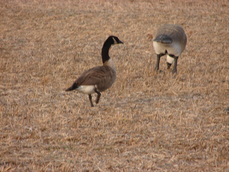 Photo by: Zachary Roes
Photo by: Zachary Roes
Canada Goose
Habitat
Open fields, open bodies of water
Range
Canada Geese travel through the Pacific, Central, Mississippi, and Atlantic flyways.As winter approaches they travel from Canada where they breed down south to warmer climates
Diet
They feed on grasses, sedges, waste grain and berries
Male and Female
Both sexes of Canada geese have a black head and neck except for broad white cheek patches extending from the throat to the rear of the eye. The female of a breeding pair is often smaller. The breast, abdomen and flanks range in coloring from a light gray to a dark chocolate brown, either blending into the black neck or being separated from it by a white collar. The back and scapulars are darker brown, the rump is blackish and the tail is blackish-brown with a U-shaped white band on the rump. The bill, legs and feet are black. Most subspecies are uniformly large and pale and exhibit a honking sound
Habitat
Open fields, open bodies of water
Range
Canada Geese travel through the Pacific, Central, Mississippi, and Atlantic flyways.As winter approaches they travel from Canada where they breed down south to warmer climates
Diet
They feed on grasses, sedges, waste grain and berries
Male and Female
Both sexes of Canada geese have a black head and neck except for broad white cheek patches extending from the throat to the rear of the eye. The female of a breeding pair is often smaller. The breast, abdomen and flanks range in coloring from a light gray to a dark chocolate brown, either blending into the black neck or being separated from it by a white collar. The back and scapulars are darker brown, the rump is blackish and the tail is blackish-brown with a U-shaped white band on the rump. The bill, legs and feet are black. Most subspecies are uniformly large and pale and exhibit a honking sound
All of the waterfowl species can be identified by female and male along with addition information about the species and other species through the Ducks Unlimited Website or one of the following Apps that they offer!
